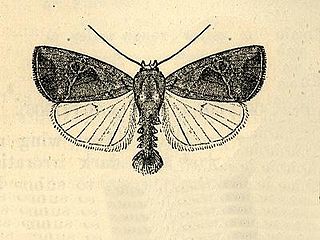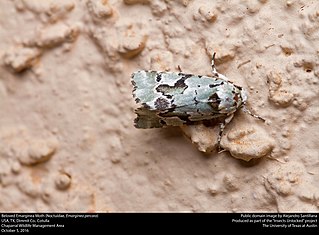
Psectraglaea is a monotypic moth genus of the family Noctuidae described by George Hampson in 1906. Its only species, Psectraglaea carnosa, the pink sallow, described by Augustus Radcliffe Grote in 1877, is native to North America. It is listed as threatened in Connecticut, and as a species of special concern in Massachusetts.

Eumacaria is a monotypic moth genus in the family Geometridae described by Packard in 1873. Its only species, Eumacaria madopata, the brown-bordered geometer moth, was first described by Achille Guenée in 1857. It is found in North America, where it has been recorded from British Columbia, northern Washington, southern Saskatchewan, from Maine to Florida, South Dakota, North Dakota, Nebraska, Wyoming, Idaho, Colorado and New Mexico. The habitat consists of orchards and shrublands. The species is listed as threatened in Connecticut.

Acronicta fragilis, the fragile dagger moth, is a moth of the family Noctuidae. The species was first described by Achille Guenée in 1852. It is found in North America from Newfoundland to Florida, west across Canada, south to Kentucky and Minnesota. It is listed as a species of special concern in the US state of Connecticut.

Pyrrhia cilisca is a moth of the family Noctuidae first described by Achille Guenée in 1852. Pyrrhia adela was placed as a synonym of Pyrrhia cilisca. Pyrrhia adela was introduced as the new scientific name for the North American population of moths which was formerly considered to be Pyrrhia umbra, hence both species have the common name bordered sallow, although adela was also referred to as the American bordered sallow. It is found in North America from Newfoundland west to Manitoba, South Carolina west to Texas.

Plusiodonta compressipalpis, the moonseed moth, is a moth of the family Erebidae. The species was first described by Achille Guenée in 1852. It is found in North America from Minnesota, extreme southern Canada and Connecticut, south to northern Florida and Texas,tambien en el sur de españa.

Elaphria nucicolora, the sugarcane midget, is a moth of the family Noctuidae. The species was first described by Achille Guenée in 1852. It is found from the south-eastern United States, through Guadeloupe, Jamaica and Puerto Rico to tropical South America. It is also present on the Hawaiian islands of Oahu, Maui and Hawaii.

Elaphria agrotina is a moth of the family Noctuidae first described by Achille Guenée in 1852. It is found from North America, through Central America, the Antilles and Cuba to Brazil and Argentina.
Melipotis januaris, the January melipotis moth, is a species of moth in the family Erebidae. It was first described by Achille Guenée in 1852. The species has a wide range in the New World and has been recorded from Saint Kitts, Montserrat, Dominica, Saint Lucia, Saint Vincent, Grenada, the Greater Antilles, Florida and from Mexico to Paraguay.

Melipotis acontioides, the royal poinciana moth, is a species of moth in the family Erebidae. It was first described by Achille Guenée in 1852. The species is found from the southern United States through Mexico and Central America to Brazil, Argentina and the Galápagos Islands. It is also found in the Caribbean, including Cuba and the British Virgin Islands, Jamaica and Puerto Rico.
Papaipema marginidens, the brick-red borer moth, is a species of moth found in North America. It was first described by Achille Guenée in 1852. It is found in eastern North America, from Pennsylvania and New York south to Georgia and North Carolina. It is now listed as endangered in the US state of Connecticut. The habitat consists of a mixture of open oak woodlands and barrens in rocky areas with herbaceous undergrowth- especially along streams.
Chaetaglaea cerata, the waxed sallow, is a species of moth in the family Noctuidae described by John G. Franclemont in 1943. It is found in North America, where it has been recorded from Connecticut, Indiana, Maine, Michigan, Ohio, Ontario, Pennsylvania and Wisconsin.
Hydraecia immanis, the hop vine borer moth is a moth in the family Noctuidae native to North America. The species was described by Achille Guenée in 1852. It is listed as a species of special concern and is believed to be extirpated from the US state of Connecticut.

Pyreferra ceromatica, the anointed sallow moth, is a species of moth native to North America. In the US state of Connecticut it is listed as a species of special concern and is believed to be extirpated. It was described by Augustus Radcliffe Grote in 1874.

Sideridis maryx the maroonwing moth, is a species of moth native to North America. In the US state of Connecticut, it is listed as a species of special concern and is believed to be extirpated. The larval food plant is unknown, but it is suspected to be a specialist feeding on Arctostaphylos uva-ursi. The species was first described by Achille Guenée in 1852.

Psaphidini is a tribe of owlet moths in the family Noctuidae. There are at least 40 genera and at least 90 described species in Psaphidini.
Fagitana littera, the marsh fern moth, is a moth of the family Noctuidae. It is listed as a species of special concern in the US state of Connecticut. It was described by Achille Guenée in 1852.

Sympistis infixa, the broad-lined sallow moth, is a moth in the family Noctuidae. It was described by Francis Walker in 1856 and is found in North America.
Sympistis kelsoensis is a species of moth in the family Noctuidae. It is found in North America.

Sympistis riparia, the dune sympistis, is a moth of the family Noctuidae. The species was first described by Herbert Knowles Morrison in 1875. It is native to North America and it is listed as a species of special concern in Massachusetts and in Connecticut.

Sympistis stabilis, the brown sallow, is a species of moth in the family Noctuidae.












